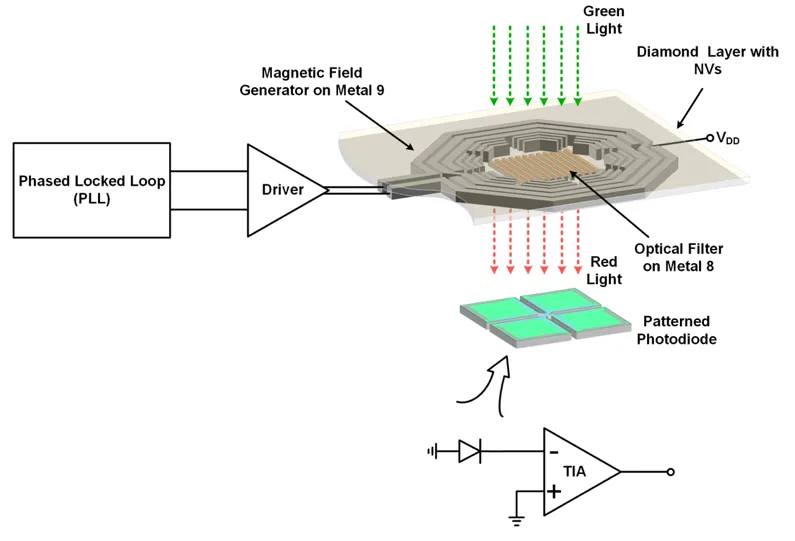Chip-Scale Quantum Magnetometry under Ambient Conditions through the Integration of CMOS Electronics with Diamond Spins
Nitrogen vacancies (NV) are used in quantum magnetometry for room-temperature sensors and quantum information processing. Quantum magnetometry enables other applications such as nuclear magnetic resonance imaging, object detection and tracking, and navigation.
Researchers
-
on-chip detection of spin states in color centers for metrology and information processing
United States of America | Granted | 10,962,610 -
on-chip detection of spin states in color centers for metrology and information processing
Patent Cooperation Treaty | Published application
Figures
Technology:
A single-chip spin-control/detection system using standard CMOS processes is implemented to address the problem of scalability. Through a tightly-integrated microwave launcher, photonic filter, and sensor, the CMOS circuits offer more direct physical interactions with the quantum states, rather than being used as simple electronic I/O modules. This enables ultra-compact and highly scalable platforms for room-temperature quantum sensing and information processing under cryogenic conditions . On-chip CMOS integration decreases the form factor and fabrication costs since the magnetometer system can be made through standard CMOS fabrication processes.
Problem Addressed:
Vector based magnetic detection with high sensitivity, as well as magnetic imaging with nanoscale spatial resolution have been proven with past NV technology. In addition, NV centers have been investigated for quantum information processing application. However, NV-based platforms require bulky and discrete instruments to control and measure spin states, which makes them impractical and difficult to scale up. Furthermore, current NV-based quantum systems have not presented a way to manipulate the spin states and measure those spin states at the same time on the same chip.
Advantages:
- Small form factor; can fabricate small, single-chip, systems using standard CMOS processes
- Scalable CMOS implementation; enabling quantum-enhanced sensing at room temperature and quantum information processing at cryogenic temperature.
- On-chip spin state readout
- Easy integration of control logic
- Less I/O
- Closed-loop feedback between spin-manipulation and readout
Publications
Donggyu Kim, et al. A CMOS-integrated quantum sensor based on nitrogen–vacancy centres. Nature Electronics. 2019 Jul 23. doi: 10.1038/s41928-019-0275-5
Mohamed I. Ibrahim, et al. Room-temperature quantum sensing in CMOS: On-chip detection of electronic spin states in diamond color centers for magnetometry. IEEE VLSI Circuits Symposium. 2018 Jun 18-22. doi: 10.1109/VLSIC.2018.8502329
Mohamed I. Ibrahim, et al. A scalable quantum magnetometer in 65nm CMOS with vector-field detection capability. IEEE. 2019 Feb 17-21. doi: 10.1109/ISSCC.2019.8662434
License this technology
Interested in this technology? Connect with our experienced licensing team to initiate the process.
Sign up for technology updates
Sign up now to receive the latest updates on cutting-edge technologies and innovations.
